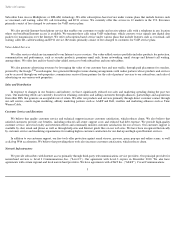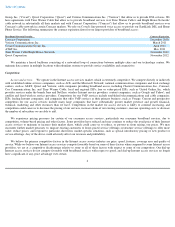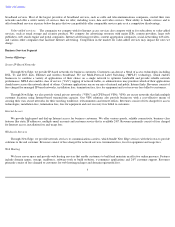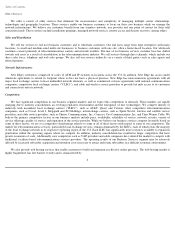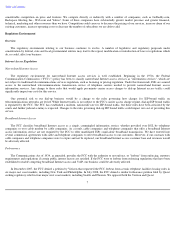Earthlink 2009 Annual Report Download - page 17
Download and view the complete annual report
Please find page 17 of the 2009 Earthlink annual report below. You can navigate through the pages in the report by either clicking on the pages listed below, or by using the keyword search tool below to find specific information within the annual report.
Table of Contents
competition in these markets and we expect this competition to intensify. These markets are rapidly changing due to industry consolidation, an
evolving regulatory environment and the emergence of new technologies. We compete directly or indirectly with ILECs, such as AT&T, Qwest
and Verizon; other competitive telecommunications companies, such as Covad, Level 3, Megapath and XO Holdings; interexchange carriers,
such as Sprint Nextel; wireless and satellite service providers; and cable service providers, such as Charter Communications, Inc., Comcast, Cox
Communications, Inc. and Time Warner Cable. We believe the primary competitive factors in our business markets include price, availability,
reliability of service, network security, variety of service offerings, quality of service and reputation of the service provider. While we believe
our business services compete favorably based on some of these
factors, we are at a competitive disadvantage relative to some or all of these
factors with respect to some of our competitors. The market for telecommunications services, particularly local exchange services, remains
dominated by the ILECs, each of which owns the majority of the local exchange network in its respective operating region of the U.S. Each
ILEC has significantly more resources available to expand its penetration within the operating regions where we compete. In addition, industry
consolidation has resulted in larger competitors that have greater economies of scale. Additionally, new competitors such as VoIP providers and
cable companies have entered the market to compete with traditional, facilities-
based telecommunications services providers. The operating
results of our Business Services segment may be adversely affected by increased subscriber acquisition and retention costs necessary to attract
and retain subscribers in a difficult economic environment.
We also provide web hosting services to enable customers to build and maintain an effective online presence. The web hosting market is
highly fragmented, has low barriers to entry and is characterized by considerable competition on price and features. We compete directly or
indirectly with a number of companies, such as GoDaddy.com, Rackspace Hosting, Inc., Web.com and Yahoo!. Some of these companies have
substantially greater market presence and greater financial, technical, marketing and other resources than we have. Competition could cause us to
decrease the pricing of our services, increase churn of our existing customers, increase operating costs or decrease the number of subscribers we
are able to add, which would result in lower revenues and profits.
Adverse economic conditions may harm our business.
Unfavorable economic conditions, including recession and disruptions to the credit and financial markets, could cause customers to slow
spending. Our consumer access services are discretionary and dependent upon levels of consumer spending. In addition, our business customers
are particularly exposed to a weak economy. Diminished corporate spending, corporate downsizing and tightened credit have had, and may
continue to have, an adverse effect on revenues and churn rates, and have resulted in, and may continue to result in, increased business customer
demands for price reductions in connection with contract renewals. In addition, during challenging economic times our business customers may
face issues gaining timely access to sufficient credit, which may impair the ability of our customers to pay for services they have purchased. Any
of the above could cause us to increase our allowance for doubtful accounts and write-
offs of accounts receivable, to impair amounts capitalized
as intangible assets, or otherwise have a material adverse effect on our business, financial position, results of operations and cash flows. Finally,
our cash, cash equivalents and marketable securities are subject to general credit, liquidity, market, and interest rate risks, which may be
exacerbated by unfavorable economic conditions. If financial markets experience prolonged periods of decline, the value or liquidity of our cash,
cash equivalents and marketable securities could decline and result in an other-than-
temporary decline in fair value, which could adversely affect
our financial condition and operating results.
We are also susceptible to risks associated with the potential financial instability of the vendors and third parties on which we rely to
provide services or to which we outsource certain functions. The economic conditions that may affect our customers also could adversely affect
vendors and third parties and lead to significant increases in prices, reduction in quality or the bankruptcy of our vendors or third
13


